Local notes
|
Wildlife Moments on Maiden Erlegh Lake during Lockdown
Our chairman has been using his lockdown exercise periods to record events around the nature reserve.
Shovelers’ courtship, 1 April
Visiting shovelers have become a feature of the winter at Maiden Erlegh Lake, varying from half a dozen to the great flocks we had two or three years ago. They are not residents however, and depart each spring to the breeding grounds. So I was surprised, and rather captivated by the sight of their courtship this year. Staying later than usual it seems, they could be seen at times facing each other and bobbing their heads up and down. It’s quite distinctive. But only days later they were gone – no shoveler ducklings for us to see.
Game, 3 April
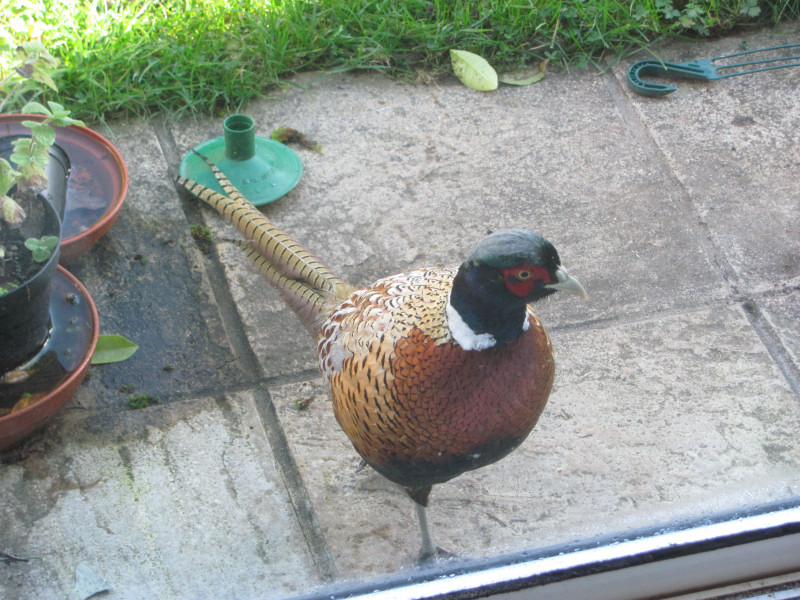 Maiden Erlegh Nature Research abounds with birds – corvids, passerines, songbirds, waterfowl – but isn’t known for game, so it was with surprise that a chanced upon a pheasant in the middle meadow one evening. It was about 7pm, so probably dusk, when the startled bird flew off at my approach, squawking as it went. Maiden Erlegh Nature Research abounds with birds – corvids, passerines, songbirds, waterfowl – but isn’t known for game, so it was with surprise that a chanced upon a pheasant in the middle meadow one evening. It was about 7pm, so probably dusk, when the startled bird flew off at my approach, squawking as it went.
Coot conflict, 7 April
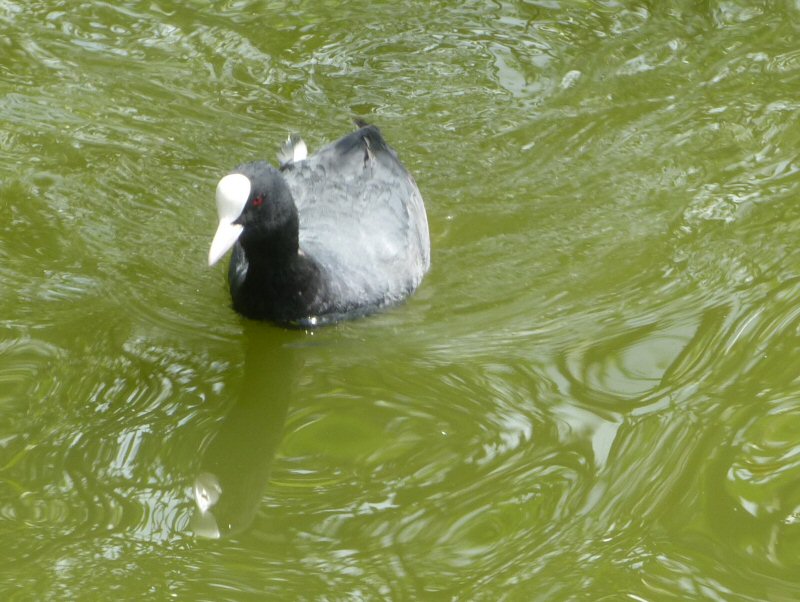 Coots are territorial and fiercely defensive, so most years will see a lot of hostile display and the occasional fight between rivals. On this occasion two coots from Swan Island chased an intruder halfway down the Lakeside bank, the fleeing coot actually flying some of the way. In front of Fishing Bay C they reversed and raised their tail fathers in hostile display. A fourth skulked out of sight beneath the overhanging vegetation next near by. The defeated coot retreated to the reed bed and then downstream to Big Island, while the assertive pair returned to their end of the reeds toward Swan Island. Coots are territorial and fiercely defensive, so most years will see a lot of hostile display and the occasional fight between rivals. On this occasion two coots from Swan Island chased an intruder halfway down the Lakeside bank, the fleeing coot actually flying some of the way. In front of Fishing Bay C they reversed and raised their tail fathers in hostile display. A fourth skulked out of sight beneath the overhanging vegetation next near by. The defeated coot retreated to the reed bed and then downstream to Big Island, while the assertive pair returned to their end of the reeds toward Swan Island.
Moorhen mating, 23 April
Conversely the passive, almost secretive moorhens are much more pacific; they are usually the victim rather than the aggressor. However, on this occasion three of them fought each other with some vigour – wings splashing in the water and claws out in front – a real cockfight. With one of them driven off, the other two mated moments later.
Breeding plumage, 23 April
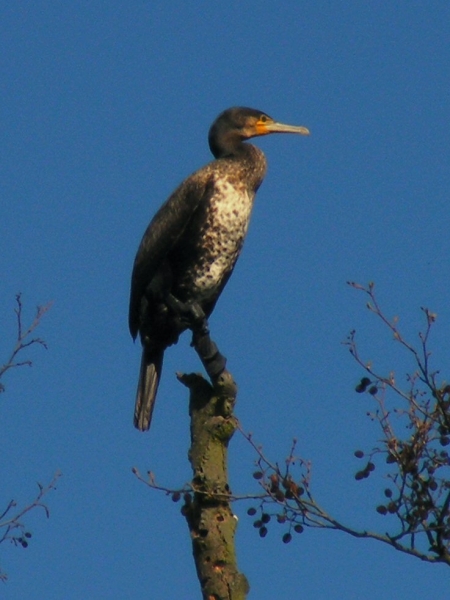 We see more cormorants, and more frequently as the years pass by, though they don’t breed in Maiden Erlegh. This year, however, their distinctive breeding plumage – large white patches on their thighs – could be seen quite clearly, on this date and several others in late April. We see more cormorants, and more frequently as the years pass by, though they don’t breed in Maiden Erlegh. This year, however, their distinctive breeding plumage – large white patches on their thighs – could be seen quite clearly, on this date and several others in late April.
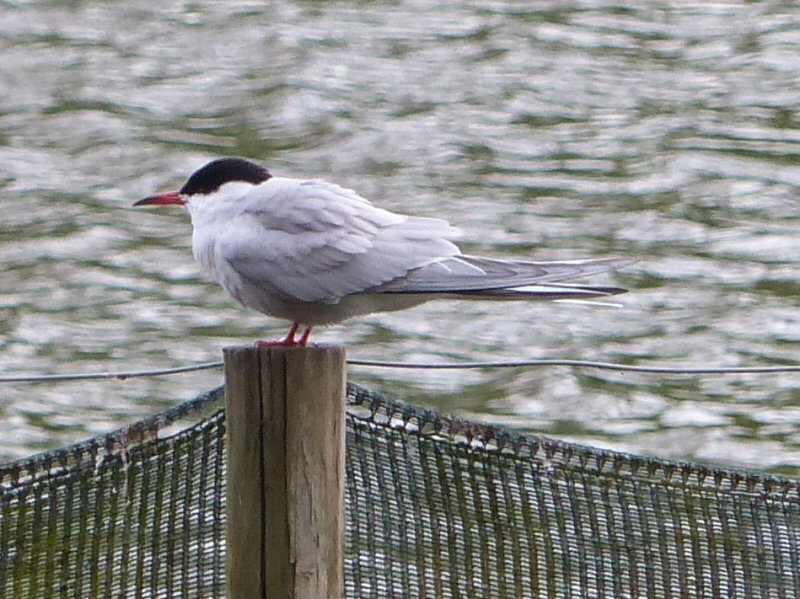
Terns’ arrival, 25 April
At last, the terns have arrived this year: two of them today.
Drama, 27 April
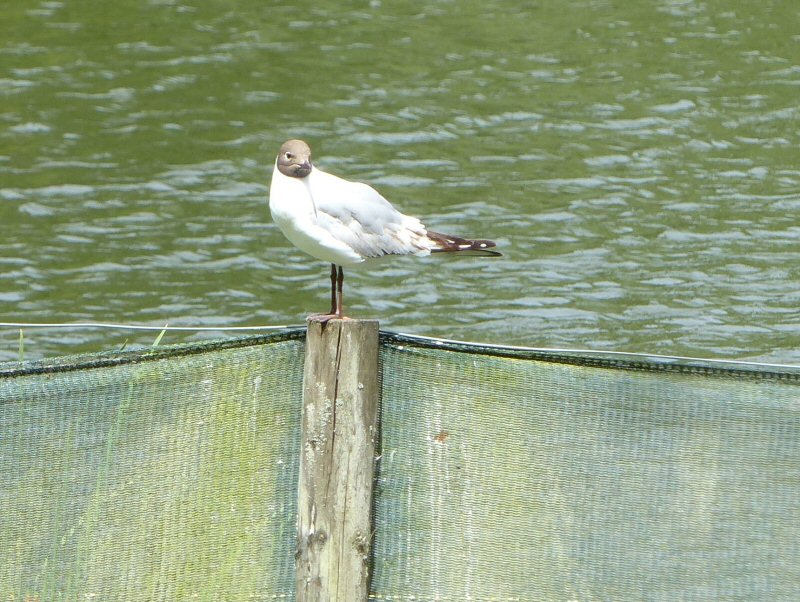 There is usually a lot of rivalry, aggression and display during the mating season, whether for territory, mating rights or defence of brood. The Canada geese and black-headed gulls have been particularly noisy this year. And on this occasion, in the early evening, it was the black-headed gulls that kicked off first. Why thy didn’t like it I do not know, for they co-exist readily enough on the fence posts around the reed bed, but a herring gull had alighted on the tern raft and the black-headed gulls took exception. Four of them mobbed the larger gull in a way they have several times this spring; (the victim in a similar situation two days later sought refuge in the water.) Then in a curious reversal, a coot drove off two black-headed gulls when they got too close at the reed bed fence. But it was the third exchange that really caught my attention (and that of a couple also passing by). A pair of Canada geese with five tiny goslings swam in the channel between Big Island the south bank. There the swan attacked them – as the swan is wont to do – and it was interesting to see how the geese reacted. It was made more fascinating by our natural concern for the safety of the newly hatched goslings. One at a time, taking turns, the adult geese would attract the swan’s attention and draw it to the bank while the gosling sheltered by the island. The target goose would then fly over the swan with a few wing beats to allow its mate to continue the taunt. Eventually the swan, after much hissing and pecking, desisted and the geese returned to their brood under the shelter of the branches. The malevolent swan, however, looped around and came for the geese again, but this time with the goslings directly in the firing line. What is remarkable is that, in the event, the swan paid no attention the helpless youngsters and the geese were able to remain in their shelter. They all survived and were seen again in the ensuing days. There is usually a lot of rivalry, aggression and display during the mating season, whether for territory, mating rights or defence of brood. The Canada geese and black-headed gulls have been particularly noisy this year. And on this occasion, in the early evening, it was the black-headed gulls that kicked off first. Why thy didn’t like it I do not know, for they co-exist readily enough on the fence posts around the reed bed, but a herring gull had alighted on the tern raft and the black-headed gulls took exception. Four of them mobbed the larger gull in a way they have several times this spring; (the victim in a similar situation two days later sought refuge in the water.) Then in a curious reversal, a coot drove off two black-headed gulls when they got too close at the reed bed fence. But it was the third exchange that really caught my attention (and that of a couple also passing by). A pair of Canada geese with five tiny goslings swam in the channel between Big Island the south bank. There the swan attacked them – as the swan is wont to do – and it was interesting to see how the geese reacted. It was made more fascinating by our natural concern for the safety of the newly hatched goslings. One at a time, taking turns, the adult geese would attract the swan’s attention and draw it to the bank while the gosling sheltered by the island. The target goose would then fly over the swan with a few wing beats to allow its mate to continue the taunt. Eventually the swan, after much hissing and pecking, desisted and the geese returned to their brood under the shelter of the branches. The malevolent swan, however, looped around and came for the geese again, but this time with the goslings directly in the firing line. What is remarkable is that, in the event, the swan paid no attention the helpless youngsters and the geese were able to remain in their shelter. They all survived and were seen again in the ensuing days.
Little Grebe, 4 May
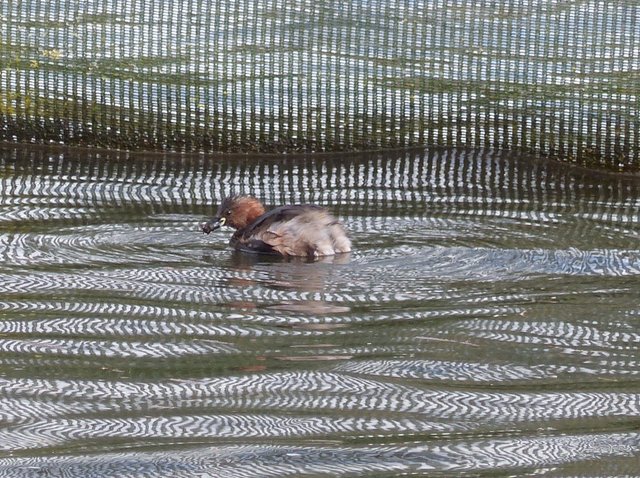 Wondering down to the lake one morning to take my usual anti-clockwise circuit I looked out from my habitual starting point in an instant saw a small brown bird, with a characteristically angled head and tail, swimming toward Swan Island. No, surely not a Little Grebe? It dived and thus confirmed the identification. Thankfully I had my camera; I must get a snap. Well that is all it was, unfortunately, but I followed along the bank as it circumnavigated the island and entered the upper lake. Let’s try digital zoom. Got it. It won’t win a wildlife photography prize, but I had captured a rare moment as these little birds are seldom seen on Maiden Erlegh Lake. They appear to visit just a couple of times each winter, so this was most unexpected in May. Wondering down to the lake one morning to take my usual anti-clockwise circuit I looked out from my habitual starting point in an instant saw a small brown bird, with a characteristically angled head and tail, swimming toward Swan Island. No, surely not a Little Grebe? It dived and thus confirmed the identification. Thankfully I had my camera; I must get a snap. Well that is all it was, unfortunately, but I followed along the bank as it circumnavigated the island and entered the upper lake. Let’s try digital zoom. Got it. It won’t win a wildlife photography prize, but I had captured a rare moment as these little birds are seldom seen on Maiden Erlegh Lake. They appear to visit just a couple of times each winter, so this was most unexpected in May.
Blackcap, 13 May
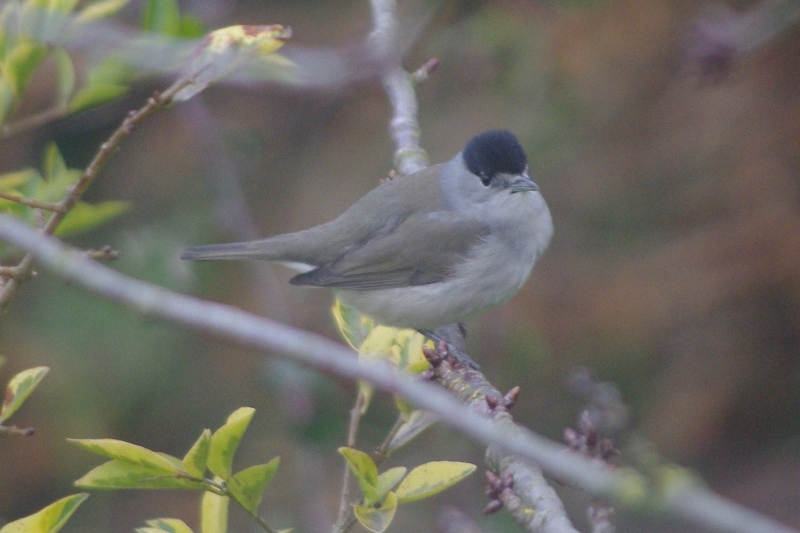 There it was, just feet away in the branches along side the path leading to the weir behind Lakeside. I fumbled for my camera as the blackcap was perfectly in view, singing on a branch. I adjusted the zoom, but too late – it was still in sight but obscured by intervening twigs and leaves. There it was, just feet away in the branches along side the path leading to the weir behind Lakeside. I fumbled for my camera as the blackcap was perfectly in view, singing on a branch. I adjusted the zoom, but too late – it was still in sight but obscured by intervening twigs and leaves.
Squirrel kit, 15 May
 I was walking with my wife Elizabeth along the edge of Oak Wood when a squirrel emerged onto the path. We paused. It looked around, saw us standing still and turned away. What was in its mouth? No acorn certainly – it was much larger – it was a baby squirrel, a ‘kit’ or ‘kitten’! The mother scampered along the path and into the branches off to one side. We followed to its point exit, scanning the trees for any sign. No luck. The squirrel duly reappeared, but without its kitten. Perhaps it was going back to relocate another kit to its new place of refuge? I was walking with my wife Elizabeth along the edge of Oak Wood when a squirrel emerged onto the path. We paused. It looked around, saw us standing still and turned away. What was in its mouth? No acorn certainly – it was much larger – it was a baby squirrel, a ‘kit’ or ‘kitten’! The mother scampered along the path and into the branches off to one side. We followed to its point exit, scanning the trees for any sign. No luck. The squirrel duly reappeared, but without its kitten. Perhaps it was going back to relocate another kit to its new place of refuge?
Heron mobbed, 19 May
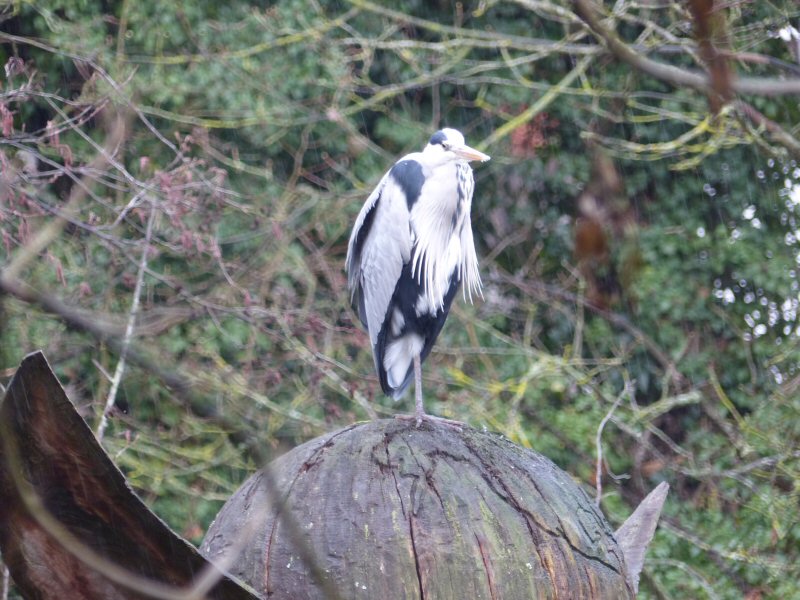 The heron is a big bird, one of the biggest on the lake, and it easy to imagine it is invulnerable. So it is surprising to see it being attacked as I have seen on three occasions this Spring. Perhaps the most notable was in the early morning of 19 May when an adult heron, in clean black-and-white head plumage, was perched upright on the reed bed fence. A black-headed gull was flying around in circles, squawking, and started to ‘dive bomb’ the heron. At every pass the heron would duck its head, its long neck bobbing up and down, while opening its beak a little as if in involuntary reflex. The whole scene was illuminated in a golden glow. Another gull joined in, though somewhat half-heartedly, and eventually the pair desisted. The heron remained unmoved. The heron is a big bird, one of the biggest on the lake, and it easy to imagine it is invulnerable. So it is surprising to see it being attacked as I have seen on three occasions this Spring. Perhaps the most notable was in the early morning of 19 May when an adult heron, in clean black-and-white head plumage, was perched upright on the reed bed fence. A black-headed gull was flying around in circles, squawking, and started to ‘dive bomb’ the heron. At every pass the heron would duck its head, its long neck bobbing up and down, while opening its beak a little as if in involuntary reflex. The whole scene was illuminated in a golden glow. Another gull joined in, though somewhat half-heartedly, and eventually the pair desisted. The heron remained unmoved.
Visiting tufted ducks, 19 May
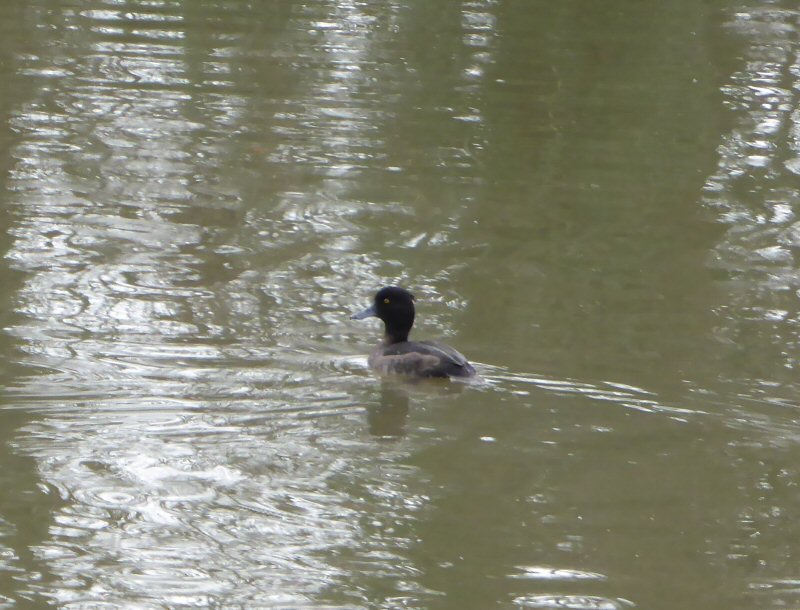 Tufted ducks are hardly rare, but we don’t see them often on Maiden Erlegh Lake. They are visitors here, just passing through. This year there was a pair, male and female, on the evening of 19 May. There today, but gone tomorrow. Tufted ducks are hardly rare, but we don’t see them often on Maiden Erlegh Lake. They are visitors here, just passing through. This year there was a pair, male and female, on the evening of 19 May. There today, but gone tomorrow.
Egyptian gosling, 24 May
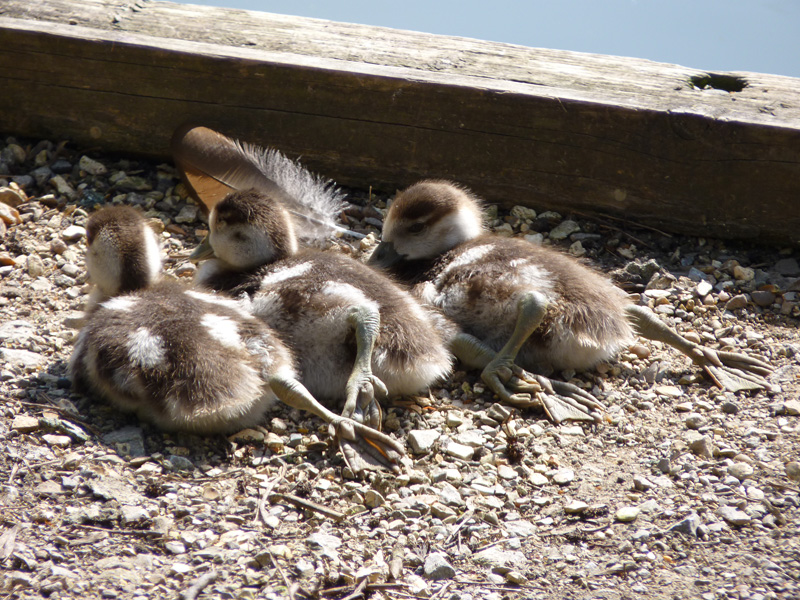 Maiden Erlegh has a resident pair of Egyptian geese, or perhaps more accurately a pair of Egyptian geese can be seen on Maiden Erlegh Lake. Is it the same pair? We assume so and every so often a third, or another pair, arrives and depending on the time of year is driven off. Their goslings are among the first of the year’s new arrivals, often appearing in February if not before. However, there haven’t been any for a couple of years, so by May it was easy to assume there wouldn’t be any in 2020. Not so. Much to my surprise I saw the adults in one of the silt pockets at 10.00 in the morning of the 24th and there between them, was a tiny ball of fluff, not much bigger than a newly hatched duckling. And at the time of writing (7th June) it survives under the watchful eye of its attentive parents. [Still there, larger and increasingly feathered, on 4 July] Maiden Erlegh has a resident pair of Egyptian geese, or perhaps more accurately a pair of Egyptian geese can be seen on Maiden Erlegh Lake. Is it the same pair? We assume so and every so often a third, or another pair, arrives and depending on the time of year is driven off. Their goslings are among the first of the year’s new arrivals, often appearing in February if not before. However, there haven’t been any for a couple of years, so by May it was easy to assume there wouldn’t be any in 2020. Not so. Much to my surprise I saw the adults in one of the silt pockets at 10.00 in the morning of the 24th and there between them, was a tiny ball of fluff, not much bigger than a newly hatched duckling. And at the time of writing (7th June) it survives under the watchful eye of its attentive parents. [Still there, larger and increasingly feathered, on 4 July]
A week of woodpecker chicks, late May / early June
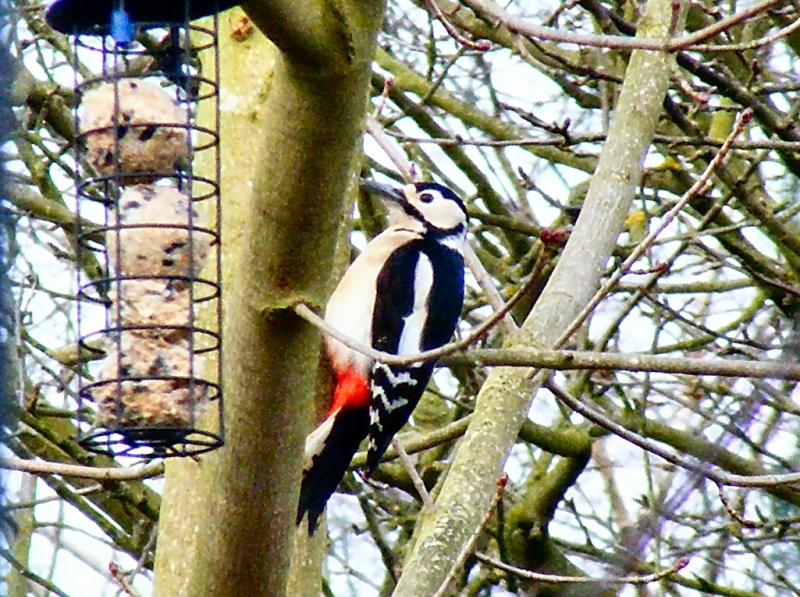 You can hear them from quite a distance away – woodpecker chicks. Their cheeping is both resonant and insistent, and initially difficult to locate. The sound fills the air. But fortunately the holes in the trees that they use as their nests are usually quite visible. I heard on them first this year on 24th May and again in the heat of the 26th and 27th. I suspected they were in the topmost of three holes high up in an oak tree in Oak Wood. Then on the 30th I saw the adult fly to the hole, and disappear entirely from view. It was a greater spotted woodpecker. As I paused on Sunday 31st the adult visited the hole as I watched, but this time it was the lower hole. Two holes: two nests! Sure enough the next time the top hole was the object of the woodpecker’s attention, only this time there were two visits in the space of a few minutes. On the 3rd June, the chicks were visible at the upper hole as the woodpecker came to feed them. The adult was unsettled, however, and signalled its alarm with a call similar to the youngsters’ cheeps, only deeper and less frequent. It flew to a nearby branch and moments later a magpie flew off. You can never be too careful! The lower hole was still in use on 4th June, but thereafter all was silent.
A spectacle on Sunday 6 June
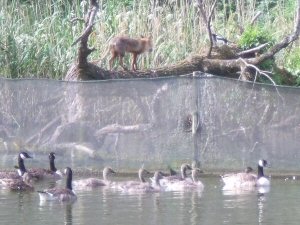 click on the picture click on the picture
to see a larger versionWalking westward along Lakeside, I saw eight Canada geese abruptly leave the shelter of the silt pocket and head across the lake; two others behind the netting opposite had turned about and retraced their route. Then the geese at the cormorant stump started to gather by the corner of the reed bed nets, as did a family of juvenile ducks. More geese, with goslings, streamed across from the fishing bays and another family of ducks emerged from behind Swan Island. There was a clear convergence of waterfowl on the fallen tree behind the reed bed fence, moorhen tails flicking in alarm. What was going on? And then I saw the fox! He was balanced on the end of a branch, head down drinking from the lake. Every so often he would lift his head and glance about before continuing to slake his thirst. He appeared unmoved by the assembly around him, no less than 27 geese, plus goslings, ducks, coots and moorhens, chicks and all. 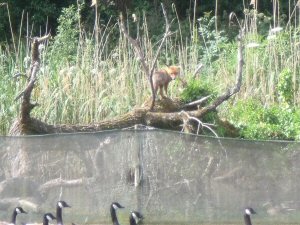 click on the picture click on the picture
to see a larger versionHis thirst quenched, the fox retreated gingerly back up the branch before pausing on the horizontal tree trunk. Two magpies were going berserk. Looking around to choose his moment, and avoid the attention of otherwise oblivious joggers on the path beyond, he slunk into the undergrowth and vanished from view. Nothing had happened as far as I could tell – no raid on a nest, no birds carried off in his jaws – but the almost magnetic attraction of a fox in what seems an uncharacteristic setting was striking. There was no panic, no flight or dispersal, but a hypnotic gathering of adults and juveniles alike as if drawn to a fascinating spectacle.
Sick hedgehog, 26 June
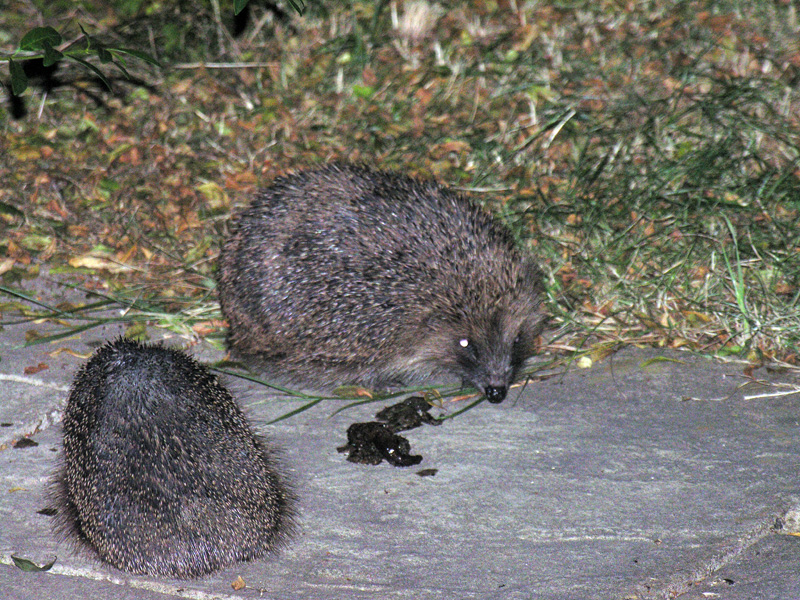 I arrived home to find Elizabeth had got back from the surgery before me. Quick, she said, there’s a sick hedgehog lying on the path. We found a box, scrunched some newspaper, picked up the gardening gloves and set off on a mission of mercy. Through Old Pond Copse we went, the woods shading us from the sun, and out onto the path. No sign. Where had it gone? We hope somebody had beaten us to it, but the prospects of recovery aren’t great. Just days later we saw another in Kenton Road, lying bloodied in the gutter. I arrived home to find Elizabeth had got back from the surgery before me. Quick, she said, there’s a sick hedgehog lying on the path. We found a box, scrunched some newspaper, picked up the gardening gloves and set off on a mission of mercy. Through Old Pond Copse we went, the woods shading us from the sun, and out onto the path. No sign. Where had it gone? We hope somebody had beaten us to it, but the prospects of recovery aren’t great. Just days later we saw another in Kenton Road, lying bloodied in the gutter.
Upside-down geese, 26 June
It was hot – gosh it was hot – and the birds would have felt it, I’m sure. Now, I’m used to seeing Canada geese ducking their heads and chests in the lake when they need to refresh, and tipping water over their backs, large silvery drops rolling slowly off their oily flight feathers. But this time, just in front of me, one of the geese rolled right over onto its back, webbed feet flailing in the air for a moment or two. And then another somersaulted head first into the water and rolled forward 180 degrees into the same inelegant position on its back. They clearly aren’t designed to stay that way up as after a few seconds of frantic wobbling, both geese bobbed back to their more natural assumption of streamlined buoyancy.
Fragile fledgling
Well, not strictly a fledgling – that’s just an alliterative device – but one of the young coots has suffered an injury. For some weeks now this one of six cootlings near the feeding station has had its right wing curled back on itself, ruining the symmetry of its lines and revealing the pale underside against its black back. It’ll never fly. But, apart from that, this coot seems unperturbed and continues to swim and feed as normal.
Great Crested Grebe, 28 June
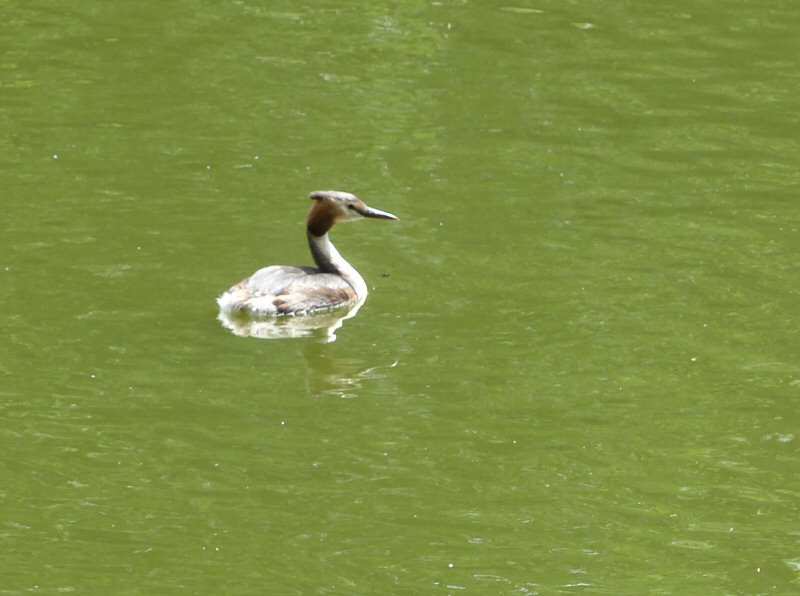 Not content with spotting a Little Grebe earlier in the summer, I took great delight in seeing a Great Crested Grebe today – the first such visitor since June 2018. There it was, seen entirely unexpectedly at the end of my walk, swimming and diving every few moments just a few feet from the north bank. The light was catching the ruddy tint of its feathers is it popped sleekly back up out of the water. I notice there have been no Cormorants for several days, reinforcing my observation that these two species tend to prosper when the other isn’t present. Not content with spotting a Little Grebe earlier in the summer, I took great delight in seeing a Great Crested Grebe today – the first such visitor since June 2018. There it was, seen entirely unexpectedly at the end of my walk, swimming and diving every few moments just a few feet from the north bank. The light was catching the ruddy tint of its feathers is it popped sleekly back up out of the water. I notice there have been no Cormorants for several days, reinforcing my observation that these two species tend to prosper when the other isn’t present.
Nine new ducklings, 2 July
“Do you fancy a walk round the lake”, I asked Elizabeth. Yes, she’d like to see the newly hatched ducklings I’d spotted yesterday. (It seems rather late for ducklings, as the males are now moulting in their annual eclipse.) Anyway, off we went along Lakeside, scouring the lake for any sign. (The last such attempt to view two new ducklings had been met with disappointment when our daughter joined me – I never saw them again!) But this time, as we got to the lifebelt, we saw them: an indeterminate number of darting balls of fluff under a cluster of twiggy branches lying in the water. It was hopeless trying to count them. Lets see if they work their way along the bank, suggested Elizabeth. So we sat on the concrete shelf towards the weir and waited. Finally they came: all nine ducklings with their mother, just feet from the bank. We had a grandstand view.
Spiderlings, 3 July
For a while I’ve been keeping an eye on the spindly spider in the top corner of our cloakroom. A smaller one appeared and days later was dead in a cobweb, the unpalatable consequence of mating I supposed, sympathising with the male’s predicament. The larger one grew larger, it seemed to me, until today, when there is now a sprinkling of 20 or so tiny spiderlings in the web around her.
Words & pictures of fox & geese by Edwin Trout, other pictures from the EEG website
|
